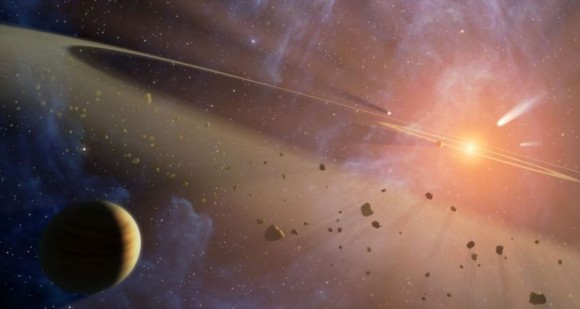Until now it was believed that only comets have a core containing water ice, this increases the possibility that water reached the earth not only from comets but also from asteroids

For the first time, astronomers have confirmed the existence of frozen water on the surface of an asteroid. The analysis of asteroid 24 Themis showed evidence of water ice combined with organic components common on the surface. The scientists say that these findings support the theory that the asteroids brought with them to Earth both the water and the organic compounds to the early Earth and thus helped to create life on the surface of the planet.
Humberto Campins of the University of Central Florida in Orlando and his colleagues recorded Themis Spectacar for over 7 hours, covering 84% of its orbit around itself. The astronomers used NASA's infrared telescope at Mauna Kea in Hawaii and revealed that the spectrum contained the presence of frozen water in all parts of the asteroid's surface that reached the visible range.
Analysis of the sunlight reflectance shows that the asteroid also contains organic components and that they are very common on the surface, Kempins said. He adds that among these substances are polycyclic aromatic hydrocarbons, CH2 and CH3.
The new findings strengthen hypotheses raised in previous observations regarding the same asteroid by Andrew Rivkin and Joshua Emery who used the infrared telescope facility. For several years, the two discovered evidence of icy water at a certain point on Themis, but did not study the asteroid for the entire period of its orbit. Together, the two teams' findings reveal that the entire surface of the asteroid is covered in water ice, Kempis said.
The 160 km wide asteroid orbits the Sun at a distance 3.2 times that of the Earth. In this area, frozen water on the surface will evaporate quickly. This means that the ice is constantly being re-formed, the source of this may be a reservoir of frozen water inside the rock.
One possibility is that the ice is buried several meters below the surface of Themis, and when it is hit by space debris, the ice finds its way to the surface. In this case, this could support a hypothesis that some asteroids resemble comets, which become active and spew materials into space when pockets of ice evaporate. Another possibility is that it is a similar activity to the one that was discovered recently on the moon, when the solar wind comes in contact with rocky surfaces without an atmosphere, water and OH are separated. Without the atmosphere, the body is exposed to the solar wind, which includes hydrogen ions. The hydrogen can bond with the oxygen on the surface of the asteroid to form water molecules.
Kempins shared his findings at the annual meeting of the American Astronomical Union's Division of Planetary Sciences.

7 תגובות
6
No way
Laitzik - excellent
And by the way, a question - if minerals are found on the asteroid, is it possible that the water will be mineral water at all???
Interesting article... thank you!
It is possible that there is reinforcement for the claim of panspermia.
Hanan Sabat
http://WWW.EURA.ORG.IL
In the second paragraph, in the second sentence, write "to cover" and not "to cover"
And if it turns out to be clean water, will it be called Tamis 4?
What is the difference between a nucleus and a kernel?
sounds interesting